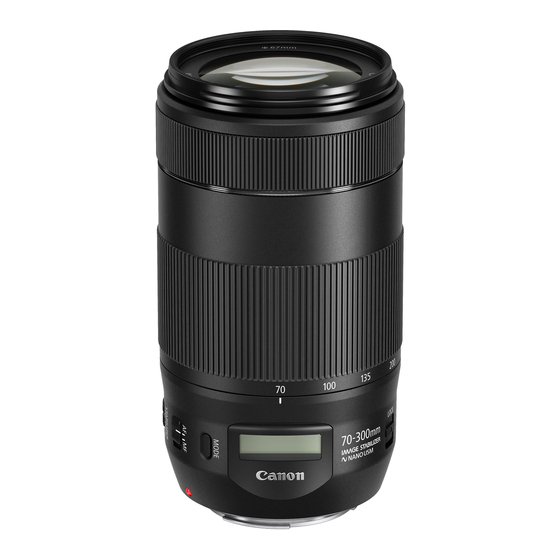
Canon EF 70-300mm f/4-5.6 IS USM Instruction
Ultrasonic image stabiliser ef lens
Hide thumbs
Also See for EF 70-300mm f/4-5.6 IS USM:
- User manual ,
- Instructions manual (26 pages) ,
- Instruction (16 pages)
Table of Contents
Advertisement
Quick Links
Advertisement
Table of Contents

Summary of Contents for Canon EF 70-300mm f/4-5.6 IS USM
- Page 1 EF70-300mm f/4-5.6 IS USM Instruction...
- Page 2 Thank you for purchasing a Canon product. Dedicated to EOS cameras, the Canon EF70- 300mm f/4-5.6 IS USM lens is a high- performance telephoto zoom lens equipped with an Image Stabilizer. ¡“IS” stands for Image Stabilizer. ¡“USM” stands for Ultrasonic Motor.
-
Page 3: Safety Precautions
a Safety Precautions a Safety Precautions • Do not look at the sun or a bright light source through the lens or camera. Doing so could result in loss of vision. Looking at the sun directly through the lens is especially hazardous. •... -
Page 4: Table Of Contents
Nomenclature Image stabilizer mode selector switch (→ 7) Hood mount (→ 5) Filter mounting thread (→ 10) Focusing ring (→ 4) Zoom ring (→ 5) Image stabilizer switch (→ 7) For detailed information, reference page numbers are provided in parentheses (→ **). Zoom position index (→... -
Page 5: Focusing Ring
1. Mounting and Detaching the Lens See your camera’s instructions for details on mounting and detaching the lens. ¡After detaching the lens, place the lens with the rear end up to prevent the lens surface and electrical contacts from getting scratched. ¡If the contacts get soiled, scratched, or have fingerprints on them, corrosion or faulty connections can result. -
Page 6: Hood Mount
3. Hood (Sold separately) The ET-65B hood can keep unwanted light out of the lens, and also protects the front of the lens from rain, snow, and dust. Attach and align the hood to the hood mount on the front of the lens, and turn the hood as shown by the arrow to secure it. -
Page 7: Zoom Ring Lock Lever
5. Fixing the Zoom Ring The zoom ring can be fixed to keep the lens at the shortest point. This function is convenient for carrying a camera on a strap because it prevents the lens from extending. Turn the zoom ring to the widest position (70mm). - Page 8 6. Image Stabilizer You can use the image stabilizer in AF or MF mode. Set the STABILIZER switch to ¡If you are not going to use the image stabilizer function, set the switch to Select the stabilizer mode. ¡MODE 1: Corrects vibrations in all directions.
- Page 9 7. Tips on Using the Image Stabilizer The image stabilizer in this lens is effective for hand-held shots under the following conditions. ● MODE 1 ¡In semi-darkened areas such as indoors or outdoors at night. ¡In locations where flash photography is prohibited, such as art museums and theater stages.
- Page 10 Tips on Using the Image Stabilizer ¡The Image Stabilizer cannot compensate for a blurred shot caused by a subject that moved. ¡Set the STABILIZER switch to you are taking pictures using the Bulb setting (long exposures). If the STABILIZER switch is set to image stabilizer function may introduce errors.
-
Page 11: Filter Mounting Thread
¡The front end of the lens rotates, so hold it when attaching the filter. ¡Only one filter may be attached. ¡If you need a polarizing filter, use the Canon Circular Polarizing Filter (58mm). ¡To adjust the polarizing filter, first remove the lens hood. - Page 12 10. Close-up Lenses (Sold separately) Attaching a 250D or 500D (58mm) Close-up Lens enables close-up photography. The magnification will be as follows: ¡Close-up Lens 250D: Can be used at the 70mm end (magnification 0.29x - 0.38x) ¡Close-up Lens 500D: Can be used (magnification 0.14x - 0.90x) Manual focusing is recommended for accurate focusing.
-
Page 13: Specifications
¡Aperture settings are specified on the camera. The camera automatically compensates for variations in the aperture setting when the camera is zoomed in or out. ¡All data listed is measured according to Canon standards. ¡Product specifications and appearance are subject to change without notice. - Page 14 CT1-7560-006 © CANON INC. 2005 2009.7...
















Need help?
Do you have a question about the EF 70-300mm f/4-5.6 IS USM and is the answer not in the manual?
Questions and answers
I USE MY 70-300M LENS WITH MY CANNOC EOS 30D , I AM UNABLE TO TAKE GOOD SHOTS AT MYLOCAL FOOTBALL TEAM GAMES ??
For photographing football games with a Canon EOS 30D and the Canon EF 70-300mm f/4-5.6 IS USM lens, use these recommended settings:
- Autofocus Mode: Use AI Servo AF to track moving subjects like players.
- AF Point: Select the center AF point only for best focus accuracy.
- Focus Method: Use Back Button Focusing to separate focus from the shutter button, allowing better control.
- Shutter Speed: Use a fast shutter speed (at least 1/1000 sec) to freeze action.
- Aperture: Set the lens to its widest aperture (f/4 to f/5.6) to allow more light and blur the background.
- ISO: Adjust ISO as needed to maintain fast shutter speed. Start around ISO 400–800 in daylight; increase in low light.
- Image Stabilization (IS): Turn IS on, especially at longer focal lengths, but consider turning it off if using fast shutter speeds.
- Drive Mode: Use continuous shooting mode to capture multiple frames quickly.
Pre-focus on areas of expected action as needed, and practice tracking subjects for better results.
This answer is automatically generated